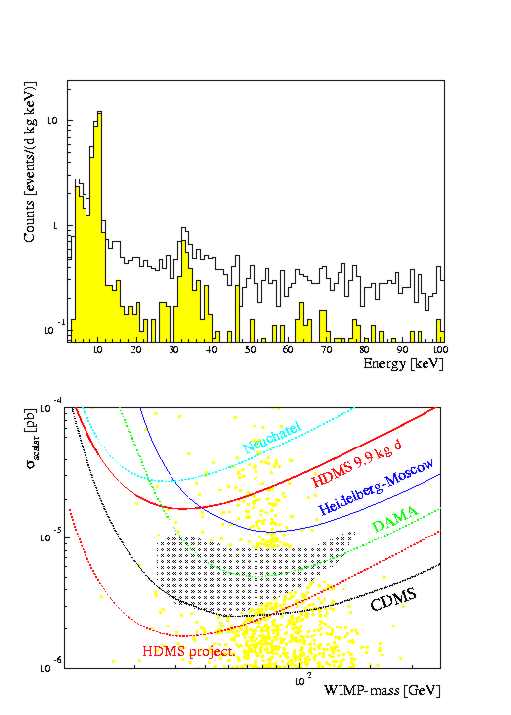| RECENT RESULTS (HDMS) |
"New constraints on spin-dependent WIMP-neutron interactions
from HDMS with natural Ge and Ge-73"
V. Bednyakov and H.V. Klapdor-Kleingrothaus and I.V. Krivosheina

In the mixed spin-scalar coupling approach the data from HDMS (Heidelberg Dark Matter Search) experiments performed in the years 1996, 1997, 2001-2003 both with natural Ge and with enriched 73Ge were simultaneously analyzed. This analysis together with a new procedure for background identification and subtraction from the measured 73Ge spectrum allowed us to obtain a significant (about one order of magnitude) improvement for the limits on the WIMP-neutron spin-dependent coupling. As a result, the HDMS experiment is now giving the most sensitive limits on the WIMP-neutron spin coupling for WIMP masses larger than 60-65 GeV/c.
| OLD RESULT (HDMS) |
"?????"
H.V. Klapdor-Kleingrothaus, C. Tomei, I.V. Krivosheina

The HDMS-prototype (for which both inner and
outer detector are made
of natural Ge) successfully took data over a period of about 15 month
in the Gran Sasso Underground Laboratory.
The picture on the left shows the spectrum of the inner detector
before and after computing the anticoincidence with the outer one.
The background reduction factor through anticoincidence is 4.3 in the
energy region 40-100 keV.
Below 20 keV the spectrum is dominated by the decays of cosmogenic
radionuclides produced during manufacturing and transportation of the
Ge-crystals and the surrounding copper at the Earth's surface (68Ge,
3H). The origin of the structure centred at 32 keV is
still unclear; it could be due to a surface 210Pb
contamination with uncomplete charge collection.
The energy threshold of the inner crystal is
2 keV, the background index between
11-40 keV
is 0.2 events per kg, day and keV.
In the region between 40-100 keV it is, with
0.07 events per kg, day and keV, already now
on the level of the HEIDELBERG-MOSCOW experiment.

The full scale experiment, 73Ge-HDMS, (new, low level Cu-crystal holder, inner detector made of enriched 73Ge) was installed at LNGS in August 2000 and already started data taking.
For evaluating the dark matter limits we considered only the last 49 days of measurement of the HDMS prototype (since the cosmogenic radionuclides produced in the Ge crystals and in the surrounding copper have typical half-lives of 300 days). The background index between 2-30 keV is 0.5 events per kg, day and keV. The resulting upper limit exclusion plot in the WIMP-nucleon cross section - WIMP-mass parameter space is shown on the left. The limit at large WIMP masses is not yet competitive with our limit from the HEIDELBERG-MOSCOW experiment. However, the cross section limits for WIMP masses below 40 GeV are considerably improved. This is mainly due to the lower energy threshold of 2 keV, compared to 9 keV in the HEIDELBERG-MOSCOW experiment.
The expectation for HDMS after 2 years
of measurement and a background index of 0.07 events
per kg, day and keV in the 2-30 keV energy region is seen on the
left. It should test the entire DAMA `evidence
region' with raw data and using a completely different
detection technique, namely ionization in a HPGe-detector.